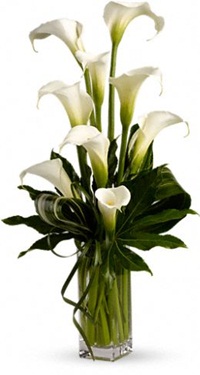
You’ll be hard pressed to find a more unusual flower with such a deeply rooted cultural and historical significance as the calla lily. Surely you’ve seen this blossom before – it’s a popular choice for weddings as well as other romantic holidays and occasions. There’s a reason behind this. Just as other flowers have a distinct symbolic meaning or associated emotions, so does the calla lily. With its ivory white petals and lush green leaves, this elegant bloom is more than just something pretty to place in a vase. In fact, these flowers have been sought after for centuries.

So what have these flowers come to represent?
Calla lilies are not true lilies!
Despite what their name suggests, calla lilies are not true lilies. In fact, they are not a calla, either. The calla lily belongs to the genus Zantedeschia and is a member of the Araceae family, along with the caladium and philodendron. It is also known as the pig lily, trumpet lily and arum lily, and begins to blossom in late spring. This flower was first cataloged in the mid 1700s. Why is the name so misleading? Because the Swedish botanist Carolus Linnaeus made a mistake when he was naming the species. Later, the German botanist Karl Koch corrected the error and established the genus Zantedeschia, but the name stuck. The calla lily is native to Southern Africa, and has a remarkable strength – it can continue to grow in water and even survive frost.
The meaning of the calla lily
It’s no surprise that the name calla lily comes from a Greek word for beauty. There’s more to their significance, though, than just a stunning appearance.
During the Victorian period in the 19th century, there was a flower language boom that meant certain flowers were associated with expressing particular feelings. That means that sending someone a bouquet delivered a very specific message based on the flowers’ meaning. There was no need for words – the recipient could decipher the intended message merely by the blossoms chosen and the way they were arranged. The calla lily plays a role in the Christian Easter service as a symbol of Jesus’ resurrection. In many paintings and other works of art throughout history, the calla lily has been depicted with the Virgin Mary or Angel of Annunciation. For this reason, it has been associated with holiness, faith and purity. Additionally, as the cone-line flowers blossom in spring, they have become symbols of youth and rebirth.
Call lily colors
Calla lilies are commonly white, but they also come in a variety of colors, including yellow, pink, green, purple, orange and black. The colored varieties are called mini calla lilies, and each carries a different meaning. While white naturally says purity and innocence, pink has a connotation of admiration and appreciation. Purple, which is often associated with royalty, denotes passion. Yellow ones can carry a multitude of meanings, but are typically associated with gratitude. Black calla lilies, which have a striking and dramatic appearance, carry a certain elegance and mystery. Though they are more of a dark purple or maroon than black, they are still highly sought after by gardeners and flower enthusiasts.
Traditions associated with the calla lily
You have likely spotted classic white calla lilies at a wedding, and that’s because they are traditional symbols of divinity, marital bliss and true devotion. More specifically, the calla lily marks the 6th wedding anniversary. However, they have also been used at funerals to represent sympathy and the purification of a departed soul. The exquisite calla lily is an appropriate flower for any occasion that involves major transitions, rebirths and new beginnings.





